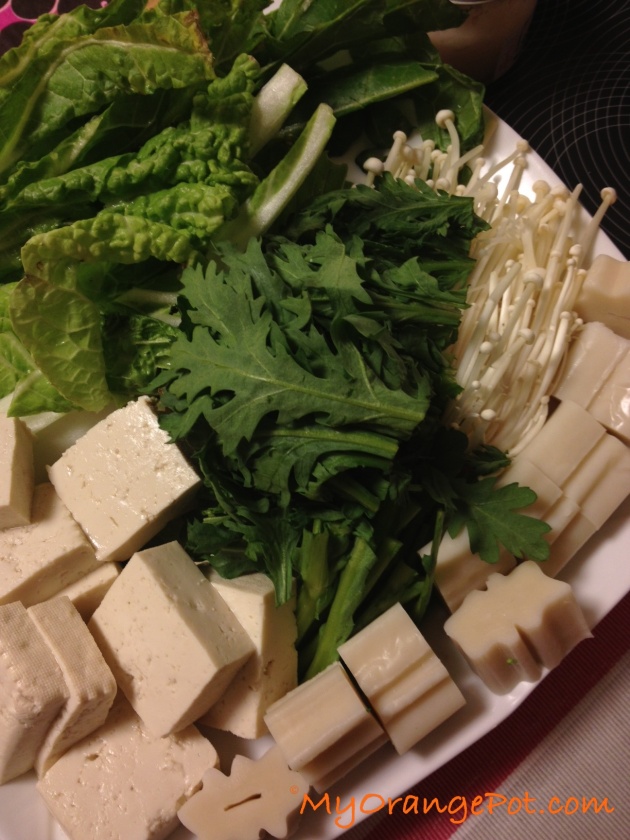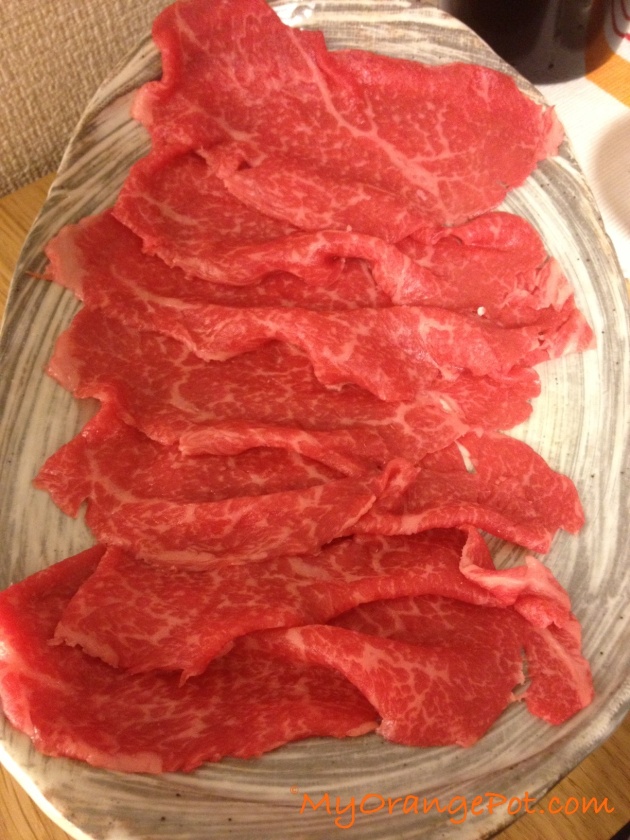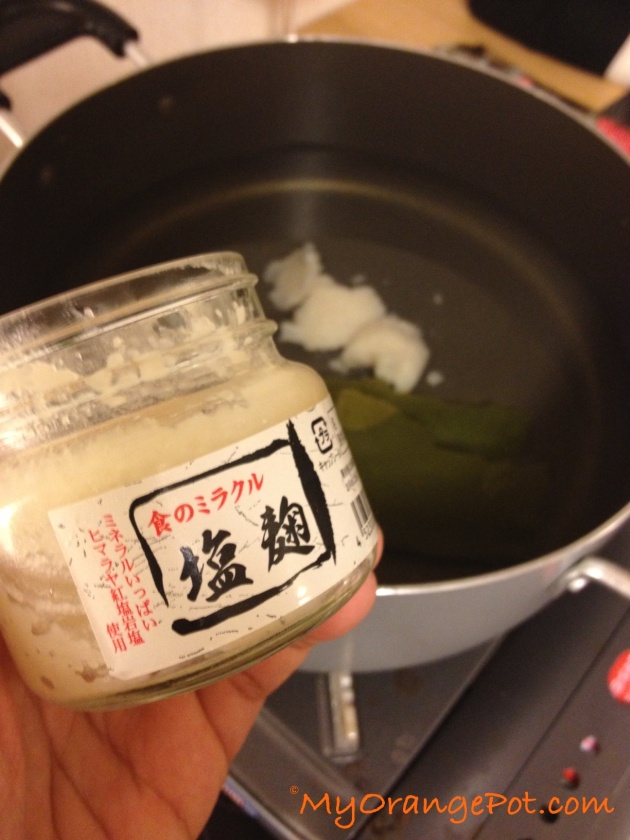It is the year of 2013, on the 9th of January to be very precise. I looked at my food blog, and in dismay I realized the last post I did was on October 6, 2012.
Noting the vast gap between that post and this one, I have bitterly concluded that the so called “Grand Plans” remain a plan unless you do something about it. And this is largely because I have 20 or so recipe drafts that remain ones unless I write the overarching post to tie them all together. I had half started some posts multiple times with many tantalizing story, but life and work happened and then Christmas and New Year’s Holiday also happened, that picking up where I left off prove to be a very challenging feat to do.
In the spirit of the New Year I have decided to discard them all and let them brew in my draft posts, perhaps forever. Instead I am going to make my first post of the year a dish that I love to have in the winter time: Beef Shabu Shabu! I also happen to have been a lucky recipient of my boss’ vegetable patch’s massive Chinese Cabbage. I received more than I know what I should do with it. And also I want to introduce my friend Emily to the wonder of this Japanese soulful dish and have her enjoy this on her last evening in Tokyo. My aim is to ingrain this memory in her brain, so when she cycles across Alaska in the coming months, the wonderful thought of this particular hot food can keep her going.
“What is a Shabu Shabu?”, I hear you ask.
It is one of Japanese traditional hot pot, up there with its buddy Sukiyaki. Whilst Sukiyaki is verging on the sweet side, Shabu-shabu is very clearly a savory dish. This hot pot usually consists of meat (pork/ beef/ chicken) – sometimes fish – and a large and free-style array of vegetables. Basically, anything you have in the fridge goes. Though I think it’s a crime if you don’t put any hakusai (Bahasa Indonesia: sawi putih, English: Chinese Cabbage) in shabu-shabu.
The name of shabu shabu itself came from the sound that happens when you mix the ingredients in the pot. Try it. If you have a metal pot and fill it with some boiling water and then you stir the water around, there is some swishing noise that sounds like, “shabu… shabu… shabu… ssssshhhh”. And I should also mention that just like any other hot pot dish, shabu shabu is best enjoyed if you have a bunch of hungry people around the hot pot to make the experience wholesome.
The whole ensemble is very uncomplicated, there is very little thing you can do to screw up the base soup. (If you do manage to screw this up, please sound off in the comment in the box below!) As you can see in the recipe later, you actually want to keep this part fairly simple. The flavor really comes into live when you dip the ingredients in the dipping sauce. There are two sauces that are very widely used in this dish, the sesame and ponzu sauce. Both are readily available in any Japanese grocery stores, but you can of course make them if you like. I don’t like to make ponzu because it’s more trouble than its worth. But sesame sauce is a whiz to make. Recipe is included here.
If you have the base soup ready, then the rest is pretty much just cutting up vegetables and getting thinly sliced meat/fish. In Japan most supermarkets carry meat that has been cut specifically for shabu shabu, but probably not so in other countries. If you live out of Japan and don’t have access to shabu shabu cut meat, then ask your butcher to slice the meat as thinly as possible, like paper thin. If they fail to produce, here’s a trick that you can do: freeze the fresh meat for about 1 hour or so. The aim of this is to make the meat hold when you are slicing it, thus do not over freeze it.
I don’t have any more wisdom to share on shabu shabu. Let’s get cutting (of the vegetables) and shabu shabu those ingredients away!!!
Shabu Shabu
Thinly sliced meat/fish
Slice and chop vegetables. Tonight I used:
Chinese cabbage
shungiku (garland chrysantemum),
tofu
enoki mushroom
chikuwabu (gluten tubes)
Parboiled udon noodles/ pre-grilled mochi cakes
Base Soup:
- In a big pot (you can use a nabe pot, or any wide mouth shallow pot): soak a piece of konbu (dried kelp) in a liter of water for at least 30 minutes
- Add 1 Tbsp of shiokoji (if you can’t get ahold of one, just go with the soaked konbu, it’s enough)
Dipping sauce:
Gomadare (Sesame Sauce): usually available in stores in bottled form. If you can’t get a hold on any, you can also make it as the below recipes:
Ponzu sauce: any Japanese shop will carry it right along side the soy sauce. But if you really want to make it, check out the recipe below:
Put the sauces into different individual bowls to serve for each person.
Directions:
- Assemble all the chopped vegetables and meat in different plates. Place strategically so everyone at the table can reach to those plates.
- Boil the concoction until it almost boils, then remove the konbu piece
- Place a portable stove in the middle of the table, put the pot with broth on it and ignite the fire
- Now the base soup is ready, you can begin your shabu shabu proces.
- Start with the meat pieces. The thinner the meat cut is, the quicker it will cook.
- Listen to the shabu shabu noise. Once the meat change colors, it’s ready.
- Dip cooked meat in any of the dipping sauce, and then eat immediately
- After several session of meat shabu shabu, you can visually see the broth slightly darkens, which indicates that the broth has been enriched by meat flavor
- Begin adding your vegetables, tofu and chikuwabu. Careful to note that some vegetables cook longer than others, so do a trial bite to each before consuming the whole lot
- Continue the process until everything is consumed!








Thank you for such a lovely evening! My last meal in Japan was also one of my best. 🙂
You are most welcome! I’m glad you enjoyed it. Now you can think about it when you need to be foodiely inspired while cycling through Alaska! How is it being back at home?